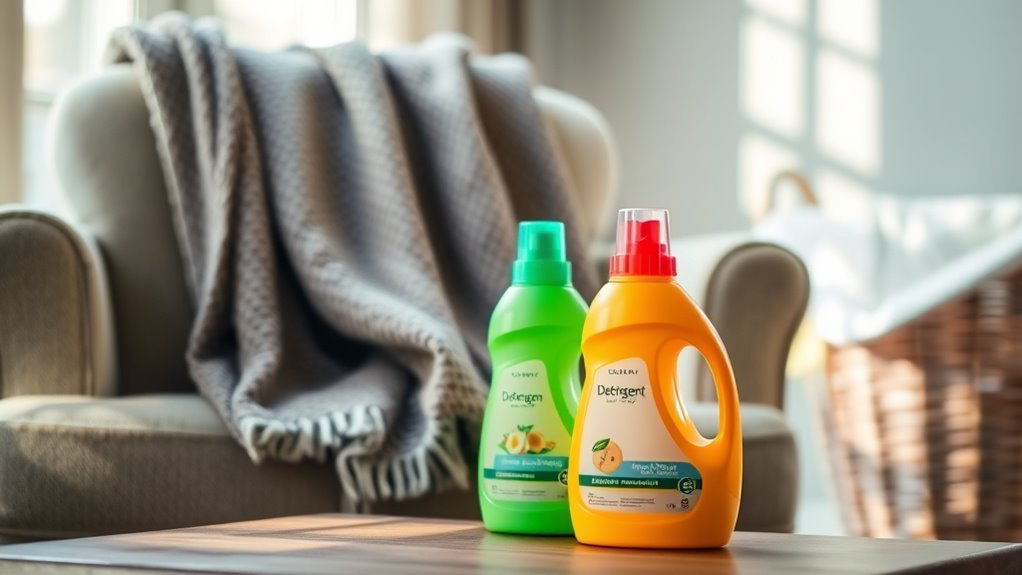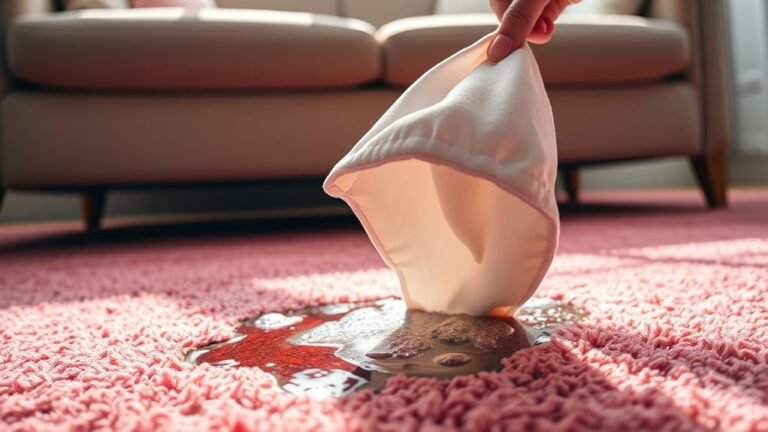Mistakes to Avoid When Cleaning Your Blanket
When cleaning your blanket, don’t use the wrong detergent—it can damage fibers and cause fading or stiffness. Avoid washing too often or too rarely, as both harm the fabric or let dirt build up. Always follow care labels to prevent shrinking or weakening. Don’t overload your washer or dryer since it stresses both your blanket and machine. Finally, be careful with drying methods to avoid mold or damage. If you want to keep your blanket soft and lasting longer, there’s more you should know.
Using the Wrong Detergent for Your Blanket Type

Why does it matter which detergent you use for your blanket? Choosing the wrong detergent type can damage your blanket’s fibers, stripping softness and durability. You deserve the freedom to enjoy your blanket’s comfort without worrying about ruined fabric. Different fabrics require specific detergent types to maintain their integrity—wool blankets need gentle, wool-safe detergents, while synthetic fibers handle standard formulas better. Using a detergent incompatible with your blanket’s fabric can lead to fading, shrinkage, or stiffness. To protect your investment and maximize comfort, always check fabric compatibility before washing. When you select the right detergent for your blanket type, you’re not just cleaning—you’re preserving freedom to relax wrapped in softness, wash after wash.
Washing Blankets Too Frequently or Infrequently
Finding the right balance for washing your blanket is essential to keep it fresh without causing unnecessary wear. Over-washing can break down the blanket fabric, while washing too infrequently lets dirt and allergens build up. To create a washing schedule that fits your lifestyle, consider these points:
- Assess how often you use your blanket and whether it’s exposed to pets, sweat, or spills.
- Identify the blanket fabric—delicate materials like wool or cashmere need less frequent cleaning than cotton or synthetic blends.
- Aim for a washing frequency that refreshes your blanket without stressing the fibers, typically every 1 to 3 months, adjusting for your environment.
Ignoring Care Labels and Manufacturer Instructions

Although it might seem convenient to skip care labels, ignoring them can lead to damaging your blanket or reducing its lifespan. Those care labels hold more than just laundry symbols—they’re your guide to keeping your blanket in top shape. The care label significance is huge because it tells you exactly how to wash, dry, and handle your blanket without causing harm. Manufacturer recommendations aren’t just suggestions; they’re tailored instructions based on the materials and construction of your blanket. When you bypass these instructions, you risk shrinking, fading, or weakening the fabric. So, if you want your blanket to stay cozy and vibrant for years, take a moment to read and follow those care labels. Freedom in cleaning means smart choices, not shortcuts that cost you in the long run.
Overloading the Washing Machine or Dryer
Following care labels is just the start when it comes to properly cleaning your blanket. Overloading the washing machine or dryer is a common mistake that can damage both your blanket and appliance. You need to respect the machine capacity and consider the blanket weight to avoid issues like:
Proper blanket care begins with following labels and not overloading your washer or dryer to protect both blanket and machine.
- Poor cleaning results due to restricted water and detergent flow.
- Excessive wear and tear on your blanket from cramped spinning.
- Potential strain on your machine that could lead to breakdowns.
Give your blanket the space it deserves to move freely during wash and dry cycles. This way, you maintain its softness and longevity while freeing yourself from worries about machine damage. Respecting machine capacity means you’re taking control, not letting your laundry routine control you.
Skipping Proper Drying Techniques

One essential step many people skip is using proper drying techniques for their blankets. If you rush drying or ignore air drying, moisture retention can lead to mold, odors, and fabric damage. To keep your blanket fresh and free, here’s a quick guide:
| Drying Method | Pros | Cons |
|---|---|---|
| Tumble Drying | Quick, convenient | Can shrink or damage fabric |
| Air Drying | Preserves fabric, no heat | Takes longer |
| Flat Drying | Prevents stretching | Requires space and time |
| Hanging Drying | Good airflow | May cause shape distortion |
Choosing the right drying technique based on your blanket’s material gives you freedom from worry and keeps it cozy for longer. Don’t skip this vital step!
Frequently Asked Questions
Can I Use Fabric Softener on All Types of Blankets?
Think of using fabric softener like adding spice to a meal—it’s great for some, but not all dishes. You shouldn’t use fabric softener on every blanket because some materials, like wool or microfiber, can get damaged. Always check your blanket washing instructions first. If you’re after softness without risks, fabric softener alternatives like vinegar or baking soda can be game-changers. This way, you keep your blankets comfy and free from harm.
How Do I Remove Pet Hair From Blankets Effectively?
To remove pet hair from blankets effectively, you’ll want to grab some reliable removal tools like a lint roller, rubber gloves, or a pet hair removal brush. Simply roll or brush the blanket’s surface to lift off the hair. You can also toss your blanket in the dryer with a dryer sheet for a few minutes to loosen stubborn pet hair. These methods’ll help you keep your blankets free and fresh.
Is It Safe to Use Bleach on Colored Blankets?
You probably want to avoid using bleach on colored blankets since it can cause color fading and damage the fabric. Instead, try bleach alternatives like oxygen-based cleaners or vinegar, which are gentler and help preserve your blanket’s vibrant colors. These options give you freedom to clean effectively without worrying about ruining your favorite cozy blanket’s look. Always check care labels first to keep your blanket fresh and colorful for longer.
What’S the Best Way to Store Blankets When Not in Use?
Brilliant blanket organization begins by choosing breathable bags or bins to banish moisture and mold. When you’re storing your snug seasonals, consider seasonal storage solutions like vacuum-sealed packs to save space and secure freshness. You’ll want to keep your cozy covers clean and cool, tucked away in a dry, dark closet or under-bed storage. This way, you’re free to fetch your favorite blanket anytime without fuss or fear of damage.
Can I Hand Wash My Blanket Instead of Using a Machine?
You absolutely can hand wash your blanket if you want more control over the cleaning process. Hand washing is gentler, letting you avoid the wear and tear that machine washing can cause. Just use mild detergent and lukewarm water, then rinse well. This method gives you the freedom to care for your blanket delicately, especially if it’s made from sensitive materials. So, if you prefer a hands-on approach, hand washing is a great choice!






